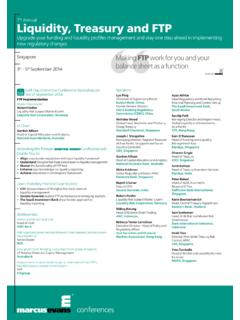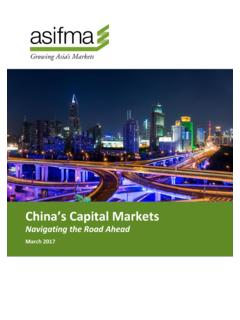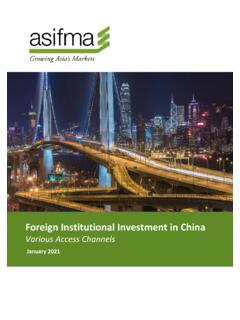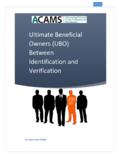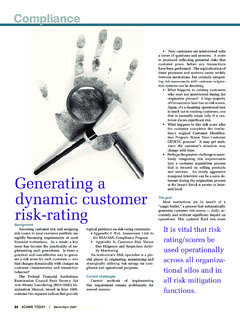Transcription of ASIFMA Best Practices for AML/KYC
1 ASIFMA Best Practices for AML/KYC June 2018 Developed with support from an ASIFMA member working group led by: 2 Contents 1. Overview .. 3 2. CDD Measures Identification of Customer .. 4 3. CDD Measures Verification of Customer .. 7 4. Beneficial Owners of Customers Identification and Verification .. 9 5. CDD Establishing Business Relationship .. 10 6. CDD Person Purporting to Act on Behalf of Customer .. 10 7. When CDD Measures Must be Carried Out .. 11 8. Simplified Customer Due Diligence ("SDD") .. 11 9. Duty to Continuously Monitor Business Relationships .. 11 10. Risk Based Approach .. 12 11. Carrying Out CDD Measures by Means of Intermediaries / Third Parties.
2 12 12. Documentation .. 13 13. Conclusion .. 14 3 1. OVERVIEW Many of the challenges of know - your -Client/Anti-Money Laundering (KYC/AML) implementation remain high on the global agenda. Differing guidelines and regulations among jurisdictions in Asia as well as divergent interpretation of these guidelines and regulations among financial institutions (FIs) have led to fragmentation, inconsistencies and varying Practices amongst FIs. In this regard, FIs have started to adopt a forward looking, client-centric and digitised approach to reduce the resource challenges associated with meeting KYC/AML requirements. Challenges in resourcing and dealing with regulatory change remain.
3 According to a 2017 survey1 conducted by Thomson Reuters, the largest FIs (USD10 billion+ turnover) saw an average spend on KYC-related procedures increase from USD142 million in 2016 to USD150 million in 2017. The number of employees working on KYC compliance in FIs rocketed from an average of 68 in 2016 to 307 in 2017. Despite the increase in headcount, approximately a third (34%) of FIs reported that resources remained the biggest challenge in conducting KYC and customer due diligence (CDD) processes, with another third (33%) considering the volume of regulatory change to be the key challenge in the KYC process. To address the above challenges, this paper proposes a set of best Practices to harmonise and standardise the application of certain key areas of AML/KYC requirements in Asia, based on input and industry feedback from a focused workgroup of ASIFMA members from both the buy side and sell side.
4 The objective of this paper is to help industry participants gain an understanding of current best Practices in the market and to drive harmonisation and standardisation in the area of AML/KYC in the Asia-Pacific region. In addition, these best Practices can also help the adoption of and interoperability between the KYC utility providers. This initiative follows an earlier survey conducted in 2017 by ASIFMA and PricewaterhouseCoopers whereby ASIFMA members and non-members were surveyed on the documents and data that they collected for four categories of institutional clients in the capital markets and trading business in 12 Asia-Pacific 55 firms both buy side and sell side responded to the survey.
5 The primary intent of this industry study was to obtain an overview of market practice to determine, based on the feedback from survey respondents, what constitutes good practice in relation to KYC Practices and associated controls. The best Practices here were drafted on the back of this survey and supplemented with specific input and industry feedback gathered in the course of several workgroup meetings with the industry. These best Practices have been drafted as generally as possible to be jurisdiction-neutral, although reference was largely drawn from industry consensus of best Practices currently applied by members in Hong Kong and Singapore. The working group identified the following key areas where it would be most useful to develop best Practices : identification and verification of customers and their beneficial owners; obtaining information when looking to establish a business relationship; identification and verification of persons purporting to act on behalf of customers; the timing of due diligence measures; the application of simplified CDD measures; 1 Thomson Reuters, KYC Compliance: The Rising Challenge for Financial Institutions 2017, available at this link.
6 2 Hong Kong, Singapore, Australia, Japan, China, India, Korea, Malaysia, Indonesia, Thailand, Taiwan, and the Philippines. 4 the monitoring of business relationships; factors to consider in developing a risk-based approach; use of intermediaries or third parties to carry out CDD; and aspects of CDD documentation. 2. CDD MEASURES IDENTIFICATION OF CUSTOMER Determining who is the customer General Depending on the specific circumstances of each customer, the following overarching non-exhaustive approaches may be used to determine who the "customer" is: the party providing instructions to the FI; or the party that contracts with the FI.
7 Funds and fund managers (A) Determining who is the customer Party providing instructions to FI and/or exercising influence and control Ordinarily, this will be the fund manager (in the context of funds) which has been delegated decision-making authority by the fund. If the party providing instructions is acting as an agent, then identity information of the underlying client would be required. Party contracting with FI This approach would mean that: if a fund manager contracts with a FI on behalf of an investment vehicle/fund, then simplified due diligence (SDD) can be performed on the fund manager provided that the fund manager has performed CDD on the fund. It may be possible to obtain limited KYC information on the fund; and if an investment vehicle or fund contracts with a FI, then CDD/SDD (as appropriate) should be applied to the investment vehicle or fund, depending on the legal form of the investment vehicle or fund.
8 In this context, a fund manager should be regarded as a person purporting to act on behalf of a customer if it has the authority to place an order on behalf of an investment vehicle or fund. (B) Equivalently regulated fund manager Where an equivalently regulated fund manager provides instructions to a FI, CDD can be performed on the fund manager rather than the fund itself. For example, in Hong Kong, "equivalent jurisdiction" is defined in the Anti-Money Laundering Ordinance (AMLO) as meaning: a jurisdiction that is a member of the Financial Action Task Force (FATF), other than Hong Kong; or a jurisdiction that imposes requirements similar to those imposed under Schedule 2 of the AMLO.
9 5 Some information should still be collected in respect of the fund on a risk-based basis. (C) Fund manager which is not equivalently regulated Where a fund manager is not equivalently regulated, then full CDD should be performed on both the fund manager and the underlying fund unless: SDD can be performed in Hong Kong under Schedule 2, Part 2, para 4 of AMLO or in Singapore under the relevant SDD provisions; or the FI can place reliance on a third party that performs the CDD as specified in the Singapore and Hong Kong laws and regulations. (D) Where the fund is customer Where the fund is considered the customer for AML/CTF purposes, FIs should nonetheless identify the fund manager and verify the fund manager's identity due to the instructions issued and control exercised by the fund manager.
10 (E) Capacity in which FI acts Where a FI is acting as: a prime broker, clearing broker, settlement agent or custodian, both the fund and the fund manager (due to instructions being provided by and control exercised by the fund manager) should be considered as customers; or an executing broker only, the fund manager (and not the investment vehicle/fund) should be considered as the customer. Trusts A similar approach should be adopted with respect to trusts. That is, the trustee should be considered the contracting party and thus the customer, although certain identification and verification information with respect to the trust should also be obtained.


